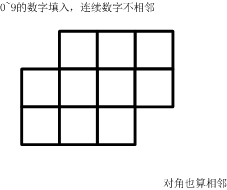题目:方格填数

填入0~9的数字。要求:连续的两个数字不能相邻。
(左右、上下、对角都算相邻)
一共有多少种可能的填数方案?
这道题以后要翻回来看看,当前解法类似于全排列
#存储节点邻居 graph_nbr={} #存储节点数值 graph_num={} for row in range(3): for col in range(4): graph_nbr[(row,col)]=[] graph_num[(row,col)]=None del graph_nbr[(0,0)] del graph_nbr[(2,3)] del graph_num[(0,0)] del graph_num[(2,3)] connect=[(-1,0),(-1,-1),(-1,1),(0,-1),(0,1),(1,-1),(1,0),(1,1)] def plus_tp(tp1,tp2): return (tp1[0]+tp2[0],tp1[1]+tp2[1]) #进行节点邻居的连接 for x in graph_nbr.keys(): for ct in connect: result_plus=plus_tp(x,ct) if result_plus in graph_nbr and result_plus not in graph_nbr[x]: graph_nbr[x].append(result_plus) #graph_key为所有节点 #n为搜索深度 #path为已走过路径 def dfs(graph_key,n,path,limit=10): #dfs结束条件 if n==limit: global count count+=1 print(count,graph_num) if n<limit: #从每个节点开始一次,注意以下break,不能直接理解为这个节点被永久跳过了,而是后续节点的dfs会出现新组合,任何一个数都有几率在当前节点 for j in graph_key: if j not in path : #判断相邻的邻居是否有n-1这个数值即比当前n的小一个且相邻的数值 has_i_prev=False for nbr in graph_nbr[j]: if graph_num[nbr]==n-1: has_i_prev=True #如果有邻居已经存在前一个数字,代表这个位置不适合存放这个数字,直接跳出 break if not has_i_prev: #将当前状态记下 graph_num[j]=n path.append(j) #进行dfs,并且保证已走过路径不会被遍历 dfs(graph_key,n+1,path) #取消当前状态,假设在最深处,那么上一层还有没遍历完的节点,上一层在遍历下一个节点的时候就可以重新组合当前pop出来的节点了 path.pop() graph_num[j]=None mark=[] count=0 dfs(graph_key=graph_num.keys(),n=0,path=mark)